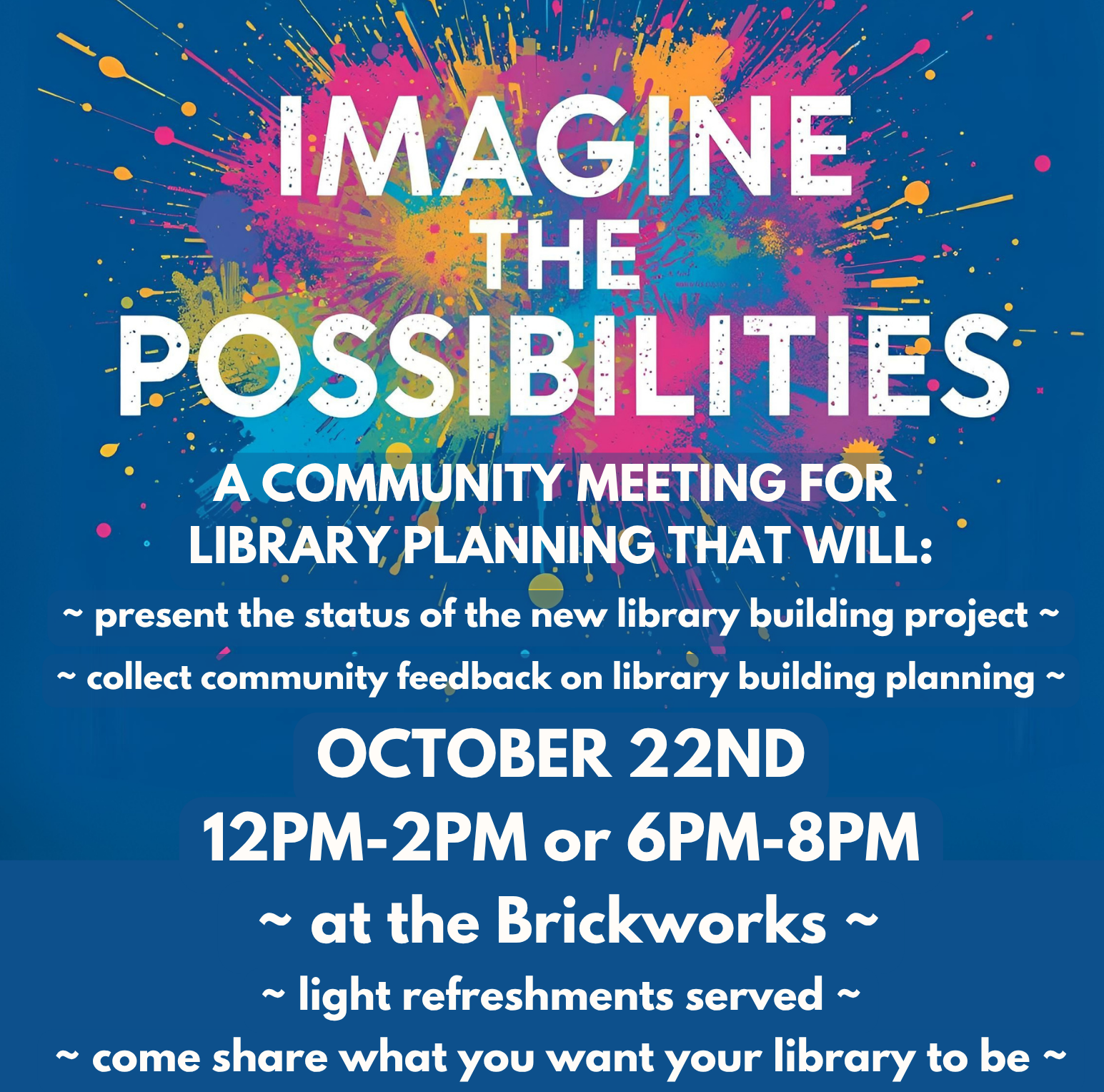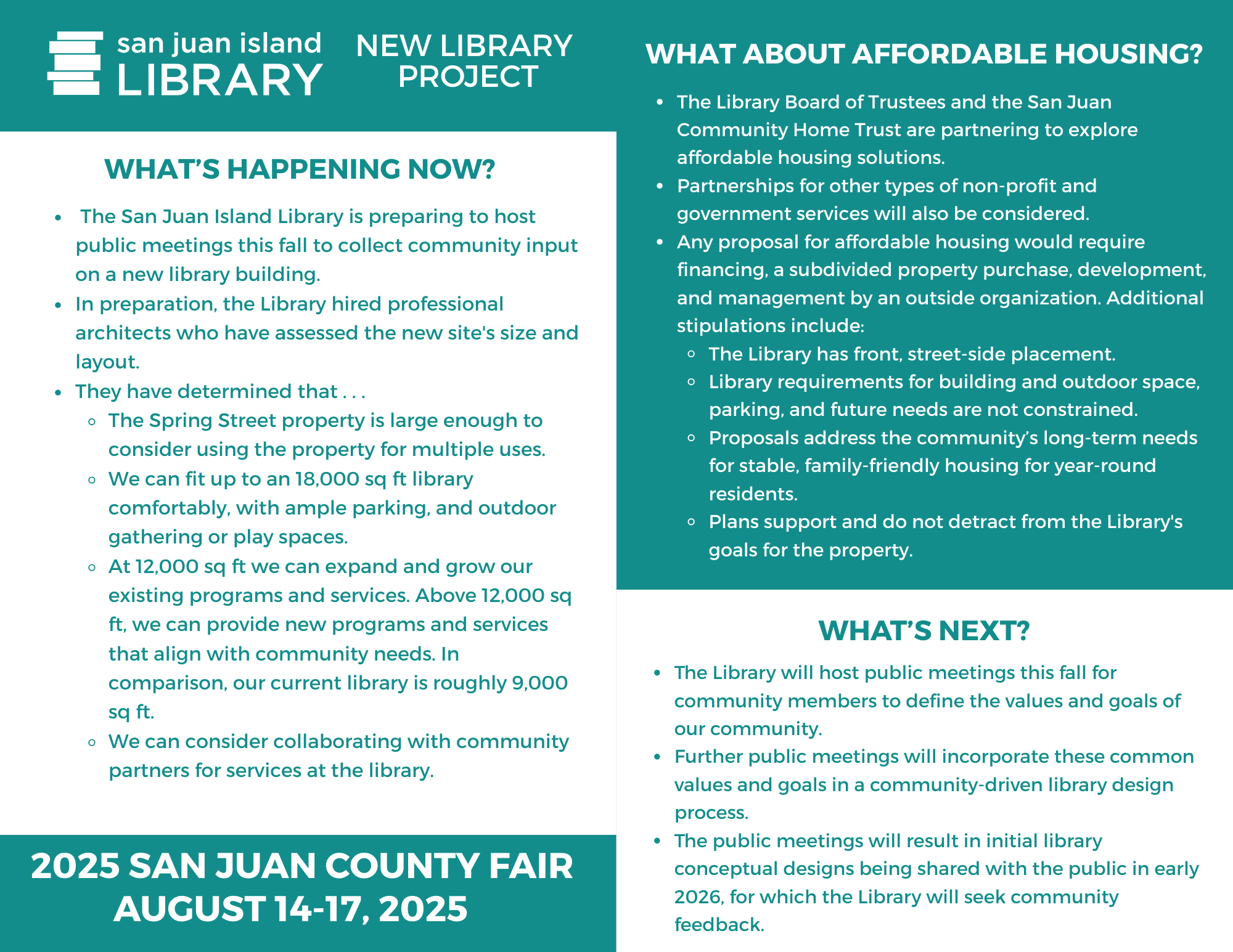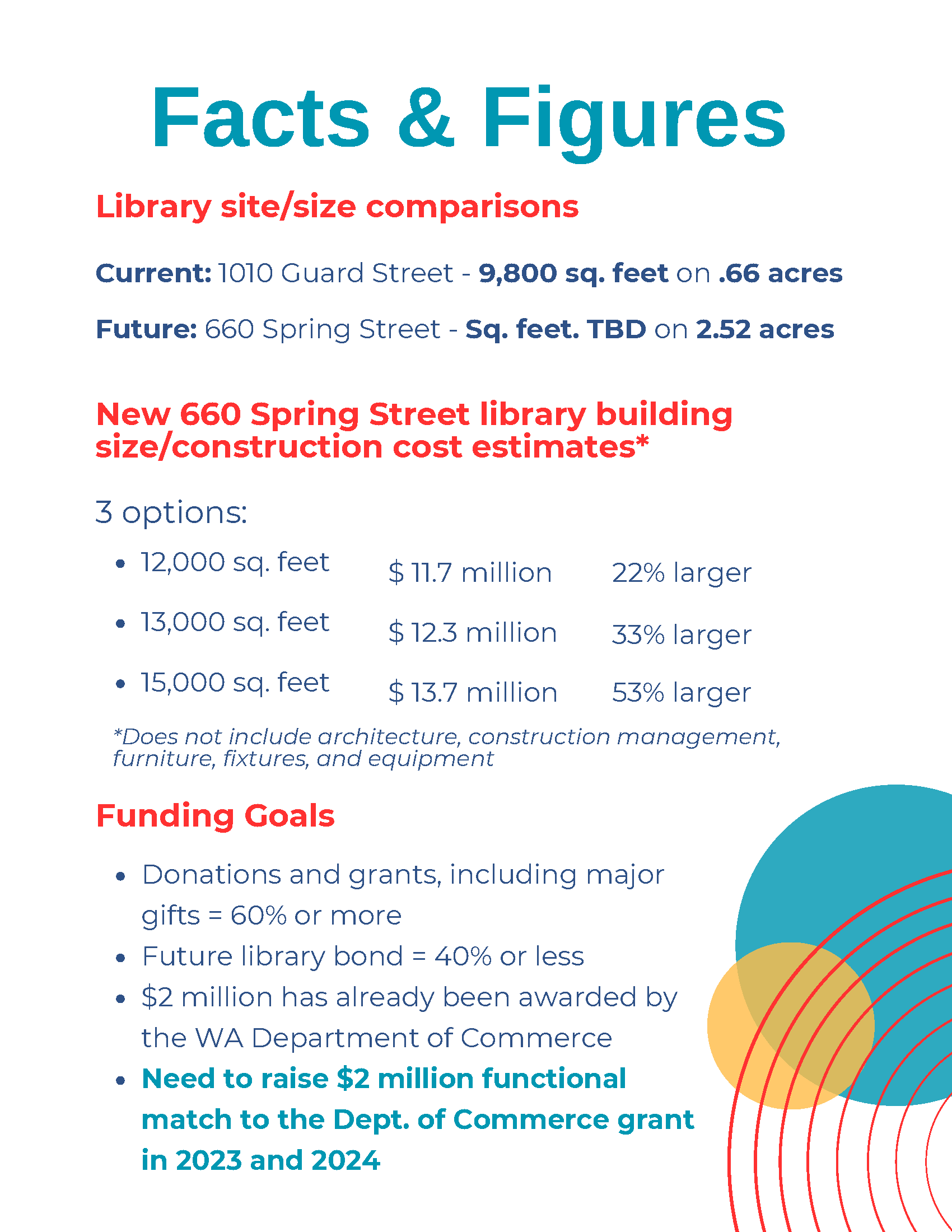Building Project Links
2023
Fall 2023 Library Project Handout August 20, 2023
Envisioning A New Library: A Public Forum June 27, 2023
2022
Bond Cost and Debt Service Scenario Used for Planning Purposes June 2022
Alternative Debt Service Scenarios June 2022
Construction Estimate Update April 2022
Library Building Project Budget Summary April 2022
Development Director Hired February 2022
2021
Building Project Update August 2021
2020
660 Spring Street Purchase Press Release December 2020
Virtual County Fair Matching Grant Program Success August 2020
Library Building Project Update August 2020
2019
Special Library Funding Work Session Minutes October 2019
Selected Property Program Study September 2019
Selected Property Study September 2019
Building Project Update September 2019
Building Project Update August 2019
SJIL Site Feasibility Report August 2019
Site Feasibility Plans August 2019
Special Board Meeting Minutes August 2019
Special Board Meeting Minutes July 2019
Special Board Meeting Minutes July 2019
Summary of Property Evaluation to Select Properties for Site Studies July 2019
Timeline July 2019
Appendices July 2019
2018
Building Project Update Handout August 2018
Community Meetings Feedback June 2018
Results from Our Community Meetings June 2018
Community Handouts May 2018
Display Boards May 2018
Building Condition Assessment & Feasibility Study May 2018
Community Open Houses: Summary May 2018
Community Open Houses: Voting Results May 2018
Special Board Meeting Minutes March 2018
2016
Facility Work Session 4 Agenda September 2016
Facility Work Session 4 Packet September 2016
2015
Work Session 1 Board Retreat Draft May 2015
Work of Leaders: Planning Change May 2015
Additional Notes from Work Session 1 September 2015
Library Actions from Work Session 1 September 2015
Washington Population Trends September 2015
Work Session 3 Minutes December 2015
See a fuller timeline of past documents at Library Building Project – Timeline & Documents
A timeline of documents related to the Library Building Project.

October 22nd, 2025: The San Juan Island Library is hosting public meetings to gather input from the community about the Library’s new building project. The first meeting, scheduled for October 22nd at 12pm-2pm and again from 6pm-8pm, will present the current status of the new building project and collect feedback from the community about what needs and services they most desire from their library. Come prepared to learn about the New Building Project and ready to share your thoughts about what you want your library to be!
In preparation for community meetings, the Library hired professional architects who have assessed the new site’s size and layout. The report can be reviewed in the links below.
2025 San Juan County Fair Flyer

2023 Facts & Figures

Envisioning A New Library: A Public Forum, June 27, 2023
The San Juan Island Library District seeks to build a community embedded, supportive learning center in the heart of San Juan Island. Once realized, this new library facility will be a place where neighbors and friends can come together, forging lasting connections and creating cherished memories. It will provide ample space for community events, workshops, and gatherings that celebrate the rich tapestry of San Juan Island’s culture and heritage.
Expanding Horizons: Envisioning a New Library
The effort to raise funds to complete the 660 Spring Street library is underway!
The new and expanded library facility will feature:
- An energy efficient, well designed, functional, user-friendly building
- Minimal need for expensive building repairs and replacements, a concern both now and into the future for the current Library building.
- The technology infrastructure to support the growing demand for public availability of computer use support services
- The ability to meet the needs of a growing population with expanded services both traditional and innovative
- Well-equipped meeting spaces, a recognized community need
- Ample, flexible spaces for children, teen, and adult materials and activities, considered by the community to be core library services and severely restricted in the current building
- Enough space for seating in quiet areas for reading and study (not now available in the library or elsewhere in the community, and a need frequently expressed by users)
- Adequate, safely accessible parking, an ongoing problem at the current facility
- Outdoor spaces for library programming and use
- New technologies and services
- Ample staff workspace designed for efficiency and productivity
Your Support: Building the Dream
To make this vision a reality, we need the support of our entire community. As we embark on this transformative journey, we invite you to be a part of our library’s future.
Stay tuned to this page, our social media page, and local newspapers to learn more about our series of community forums and other opportunities to help envision a new library for San Juan Islanders.
2023 SJIL Building Project FAQs
- The current building was originally constructed as a restaurant that opened in the 1970s.
- Purchased by the Library and opened in 1983
- Underwent a major renovation in 1988
- Expanded and remodeled facility opened in 1995
- Additional renovation in 2005 to maximize usage of available space.
- It’s now been 27 years since the last expansion, and we are bursting at the seams.
- Since 2010, the population of San Juan Island has increased by 22.7%.
- Heavy and constant use since the last renovation in 2005 means that maintenance and repair costs will only continue to rise. These costs come out of the annual operating budget and could negatively affect funds available for services, collections, and staff.
- Aging infrastructure limits our technical capacity to support all user and staff needs.
- We are unable to provide sufficient work stations and outlets in quiet areas for individuals using computers—their own, or the Library’s.
- There is inadequate space for children’s materials and activities, and for teen users.
- There is no space for additional books and other materials. Offering something new means that something we currently offer has to be cut.
- We cannot meet the demands for meeting room space for public meetings, nor to host all Library programs, many of which have to be held offsite.
- There are no spaces for individuals or small groups to meet for quiet collaboration or privacy.
- The Library is noisy due to the necessary proximity of public service areas to work, study, and reading spaces, and to there being no effective separation between children’s, teen, and adult areas.
- Staff areas are crowded and inadequate to efficiently complete work assignments, process books and other media, and prepare programs for children, teens, and adults.
- Parking is inadequate and often difficult to access safely.
- An expansion into the parking lot is not an option as parking space is already inadequate.
- The building does not have the strength capacity for the addition of a second floor. Another story would also require more parking by regulation, but parking is at maximum capacity and inadequate as it is.
- Long term costs for maintenance of the current facility will only increase over time, and eventually code related changes will force renovations onto a facility that is not sized for the community anymore.
- Costs to renovate the existing facility would, per square foot, be higher than would likely be palatable and would wed the Library to the current building limits, as the current site is already not compliant with fire code.
- Increasing maintenance and repair costs for the aging building may have a substantial impact on the yearly operating budget which is limited by law to an annual growth of no more than 1%.
- If more money is needed for upkeep of the building, less money is available for materials (books, DVDs, audiobooks, equipment, databases and other digital resources) and programs for children and adults.
- Professional staff hours may need to be reduced, lessening productivity and activities necessary for public services such as interlibrary loan, the development, organization, and maintenance of the Library’s collections of books and other media, cooperation with other community organizations and agencies, public services such as instruction and other assistance with new technologies, and open hours may need to be reduced, etc.
- At today’s costs for construction materials and services, the new Library will be approximately 15,000 sq ft., around 50% bigger than the current facility.
- But . . . in addition to a larger building, on the new site will be space for increased and much improved parking, plus outdoor green space to hold Library programs and activities, space for public enjoyment, and room to grow in the future.
- An energy efficient, functional, user-friendly building designed to be a 21st century Library
- Minimal need for expensive building repairs and replacements, a concern both now and into the future for the current Library building
- The technology infrastructure to support the growing demand for public availability of computer use support services
- The ability to meet the evolving needs of a growing population with expanded services both traditional and innovative
- Well-equipped large and small meeting spaces, a recognized community need
- Ample, flexible spaces for children’s, teen’s, and adult materials and activities, considered by the community to be core Library services and severely restricted in the current building
- Enough space for seating in quiet areas for reading and study (not now available in the Library or elsewhere in the community, and a need frequently expressed by users)
- Adequate, safely accessible parking, an ongoing problem at the current facility
- Outdoor spaces for Library programming and use; currently outdoor programming must be done off-site
- New technologies and services
- Ample staff workspace designed for efficiency and productivity
- The new location is closer to the middle of town.
- Students can easily walk from public and private schools.
- The Mullis Senior Center and Village at the Harbor will be close by.
- Being on the main road through town leads to easier access for more people.
- Instead of 2/3 of an acre currently, the Library will have 2 ½ acres with space for activities, extra parking, and room for growth.
- The total project is estimated to cost $20,000,000. An updated estimate by a construction management team lists construction costs at approximately $14,500,000, including FF&E. A 2020 non-taxpayer bond for $2,075,000 to purchase the property will be retired. Architecture and construction management costs are estimated to fill the remainder of the budget amount.
- A new library building must meet current building codes for public facilities, including ADA accessibility, and must pay prevailing wages for construction following state law. Public construction is simply more expensive than private construction, even private commercial construction.
- The project needs to meet LEED Silver standards to meet the requirements of a state grant.
- There have been significant increases to costs within categories that include metals, concrete, copper, and lumber, and in some cases, labor. The pandemic and downstream effects of the war in the Ukraine have caused significant inflation to many aspects of construction.
- Although that inflation may ease between now and the time construction begins, it is unlikely that costs will go back down significantly.
- If we wait, it’s only going to get more expensive.
- In order to have funds for property acquisition, architectural services, construction, equipment and furnishings for the new Library facility, resources will be sought through:
- Contributions from private donors and foundations.
- Grants from government and private entities that fund library construction projects.
- A bond issue that would be approved by the voters; for a bond to be passed, it is necessary that 40% of voters from the previous general election vote and that 60% of those individuals vote “yes” on the bond issue.
- The regular tax levy funds the Library’s annual budget. This is an operating budget based on anticipated income primarily from a tax levy collected twice a year by the County. It does not include funding for large capital projects such as construction, site acquisition, etc. necessary for the creation of a new Library facility. By law, this budget may increase by no more than 1% each year. This would continue to be true in a new facility. The Library does not have a reserve fund dedicated to capital projects.
- The total tax increase per property is calculated by taking the total bond amount and dividing it by the total assessed value of land on San Juan Island. Each property owner is then allocated a “cost per thousand dollars” of assessed value. This means that properties with higher assessed values pay more than properties with lower assessed values. Note that the total bond does not change over time. In fact, as more properties are added to the total assessed value of land on San Juan, the allocated tax amount per thousand decreases.
- A hypothetical example is as follows:
- For a $12,000,000 of general obligations bonds with a maximum term of 21 years.
- The annual cost to a taxpayer owning a:
- $250,000 home is approximately $44 per year.
- $500,000 home is approximately $88 per year.
- $750,000 home is approximately $132 per year.
- $1,000,000 home is approximately $176 per year.
On June 12th, 2018, the library’s Board of Trustees moved to proceed with the goal of constructing a new library facility.
Since then, the Library has begun a search for Owner’s Representation for the project to start with site selection and conclude with a new building in 3-5 years.
An architectural firm will be hired to conduct feasibility studies on a number of sites in and around town. A site will likely be determined in 2019. Site acquisition will follow.
Other activities over the next year will include exploring fundraising avenues in the community, and seeking other funding opportunities elsewhere.
Designing a new building will likely begin in 2020, and the community will be very much involved.
We are energized to embark on this exciting path towards a new, modern library for our community!
June 2018 Community Meetings Feedback
Library Director Laurie Orton said, “It was pretty clear from the data collected that community members were most supportive of the option to build a new library.” Of the 134 people who indicated their preferences at the open houses and in subsequent surveys, 75% chose a new building, versus 23% who chose expansion of the current structure. “Taking into account the challenges posed by the current structure and that the cost for expanding and retrofitting an older building costs nearly as much as creating a new, carefully planned library from the ground up, it’s not surprising that people chose the new building option,” observed Orton.
The top three problems community members identified with the current building included inadequate and difficult parking, growth restrictions on the library’s various materials collections, and the need for larger meeting and program spaces for events, as attendance has outstripped capacity over the years. Additional high priorities included a more energy efficient, cost-saving building infrastructure, improved areas for teens and children, and more quiet reading spaces and computers.
“We are excited about the possibilities of a new, modern library,” said Orton, “but we still have a long way to go on this project.” Still remaining are site selection and acquisition, funding, design, and construction. The community will be involved at every step of the process.
If you were unable to attend one of our open house meetings, please find the handouts and draft feasibility report below.
The final feasibility report will be available soon.
Assessing Our Library Facilities Needs
When we ask library patrons what we could improve about our library’s facilities, the two most common answers are “more quiet space” and “parking.” In 2011, the Library surveyed the community in preparing our current Long Range Plan (for 2012-2017), and many respondents mentioned these and other facilities issues.
At the same time, the library district is facing increasing costs from building maintenance, given the age and construction of the building. We face major projects like roof replacement, improving site drainage, and ongoing efforts to keep the basement clear of water and mold.
As a result, the library district began a facilities assessment project, whose purpose is to:
- Understand the community’s needs for library space
- Understand the mechanical and maintenance issues associated with our current building and site
- Outline the options available to the community for library facilities
Facilities Assessment Process
- Beginning in 2015 the Board held four Special Work Session meetings open to the public to begin planning the process.
- In 2016 the Board tested a community survey on three focus groups. The feedback suggested that we provide more information on the state of the building and its inherent capacity for change and growth.
- In 2017 the Library hired SHKS Architects to carry out a facilities assessment and feasibility study.
Their results, with input from library staff, was presented at three community open houses in 2018:
Sunday, May 20th from 3:00 – 5:00 PM
Sunday, May 20th from 7:00 – 9:00 PM
Monday, May 21st from 1:00 – 3:00 PM
For a full description of the entire process view our timeline.
Minutes from Facilities Assessment Meetings
Although specific issues are often discussed at the regular monthly Board of Trustees meetings (3 pm on the second Tuesday of each month, in the library meeting room), we also conduct dedicated work sessions. Any meeting we conduct is an open public meeting, which we advertise in the newspaper, and the public is welcome.
The notes and minutes from our work sessions are kept along with the regular Board of Trustees meeting minutes located on our website. Additionally, we will post links here to work session and public forum meetings specifically about facilities assessment and planning.
